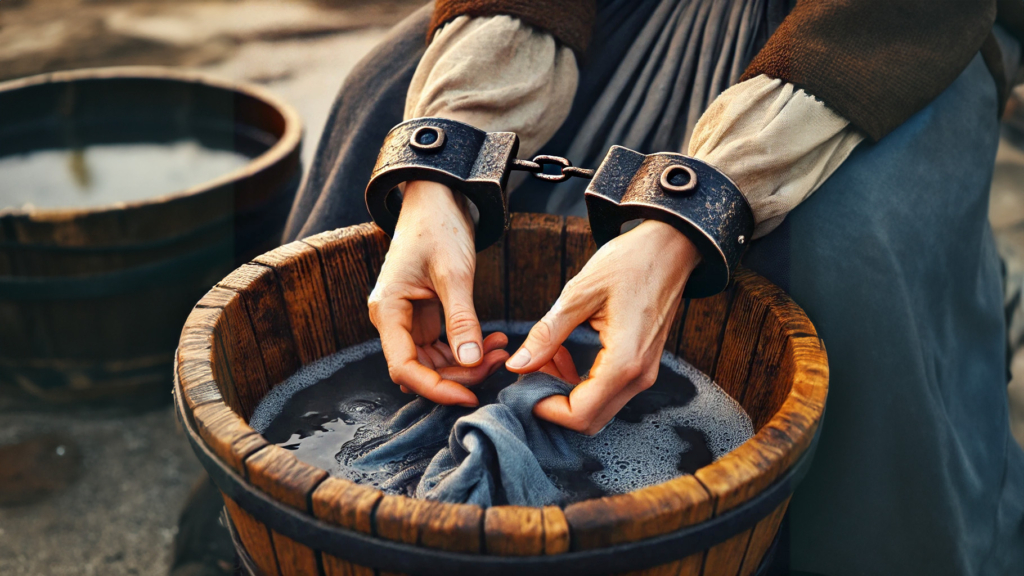One risk women who took part in military campaigns took, was being taken prisoner of war. This is the story of Lovisa von Burghausen, who was exposed to just that.
Lovisa was born in 1698 in Narva, Estonia, which at that time belonged to Sweden. Her father was Major Gustaf von Burghausen, and her mother was named Dorotea Margareta von Bundert.
During the Great Northern War (1700 – 1721), Narva was captured by Russian forces in 1704. Lovisa’s parents and four sisters were taken as prisoners, but Lovisa, not even seven years old, got separated from her family in the chaos.
Lovisa was captured by a Russian soldier and taken away. A dispute arose between the soldier who had captured her and another man, and when the first soldier refused to give up the girl, the latter became angry and stabbed her in the chest with his sword.
Lovisa survived and was taken to Moscow, where she became a servant to a Russian general named Anikita Repnin. She was sent to a convent where she was to be re-educated in the Greek-Catholic doctrine. It was a traumatic experience where she endured many beatings and mockery.

Life became a little easier when Repnin’s mother took pity on the girl, and she became part of the old lady’s entourage. But her life would change many times, and rarely for the better.
When Lovisa was 13 years old, she was forcibly married to one of the general’s servants, Johan, the son of a Swedish lieutenant who had also been captured. The marriage resulted in a daughter, whom Lovisa birthed in great pain, and who died after only six weeks. In 1713, her husband also died after being wounded in battle.
Throughout her time in General Repnin’s household, Lovisa was mistreated by the general’s wife and subjected to severe abuse. Once, she was hoisted upside down into a tree and would have surely died if the general’s mother had not intervened.

In 1713, the same year Lovisa became a widow, she changed owners. She was given to Prince Dmitri Castemir, who placed her in his household where her immediate superior was the baker’s wife. Here too, Lovisa was close to death when the wife tried to poison her to replace her with her own daughter in the princely court.
Lovisa feared for her life and dreaded being forcibly married again, so she decided to escape. It would be a difficult and arduous experience.
Lovisa von Burghausen, now 16 years old, managed to contact an English merchant who was moved by her story and agreed to help her escape. She stayed hidden with the merchant for seven weeks while he planned to get her out of Moscow and try to reunite her with her family.
However, she was discovered and brought back to Prince Castemir, who punished her severely. He chained her hands and feet and put nails in her shoes so that she could not walk long distances. It must have been extremely painful.

Lovisa was assigned a new task: washing clothes in water so cold that her hands and arms were covered in ice. She could very well have died from the treatment if the prince’s daughters had not taken pity on her and bribed the guards to bring the girl into their room at night so she could sleep warm and safe.
In 1714, Lovisa was sold yet again, this time to a Turkish merchant who lived in Siberia. There, she was put to hard labor and once again subjected to severe abuse at the slightest mistake.
But they could not completely break Lovisa, who was still determined to escape. She managed to contact another Swedish prisoner of war, Lieutenant Magnus Vilhelm Sprengtporten, whom Lovisa would later describe as “next to God her savior.”
Together, they forged new plans for her escape…

On the day of Lovisa’s escape, her owner was away. She managed to slip away from her guards and reached her rescuer, Sprengtporten, who took her to his friend, Captain Johan Reutercrona, where she was hidden for eleven weeks.
When Lovisa’s owner returned to the city, he began searching for her. A reward of one hundred ducats was offered to anyone who brought her back. She was nearly discovered several times, but her protectors managed to keep her hidden.
Eventually, they hired a farmer willing to take Lovisa out of town. She traveled disguised as a boy. The plan nearly ended in disaster when one night they stayed with a peasant family who suspected that the young “boy” was rich. They planned to murder them during the night to steal their money.
However, Lovisa was fortunate again. They were warned by a maid in the house and had to flee in haste.

After further hardships, Lovisa managed to reach Solikamsk where her parents lived. They were reunited on Christmas Day 1718, after 14 years apart.
Thereafter, Lovisa’s life became much calmer. In 1720, she married the priest Lars Sandmark, who was 30 years her senior. After the peace treaty the following year, the couple moved to Sweden.
After her husband’s death in 1729, she remarried the priest who succeeded him. However, Lovisa’s body had suffered greatly from all her ordeals and harsh treatment, and she died on January 20, 1733, only 35 years old.
Source:
Åberg, Alf. Karolinska kvinnoöden. (1999)

